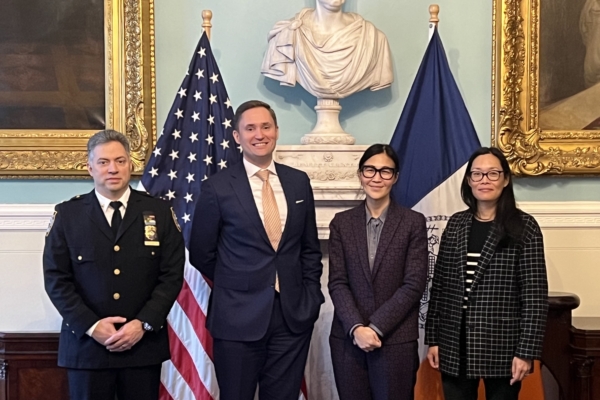The “Chinatown Connections” project, announced by Mayor Adams in February 2024 with an investment of $56 million, is nearing its one-year mark. On January 22nd (Wednesday), city officials held a media roundtable meeting to provide updates and explanations on the community’s focal points. Concerning the issue of reopening Park Row in Chinatown, the city department announced on the 22nd that after several weeks of deliberation, the decision has been made to keep Park Row closed.
Top New York City officials including Ya-Ting Liu, the Chief Public Realm Officer, Sun Huijun, Senior Vice President of the New York City Economic Development Corporation (EDC), Ed Pincar, the Manhattan Director of the New York City Department of Transportation, and Jason S. Huerta, Deputy Director of Counterterrorism at the NYPD, attended the meeting to present and answer media inquiries regarding the project.
The EDC emphasized that the “Chinatown Connections” project is primarily aimed at expanding Liu Jin Plaza, constructing a new archway, and beautifying Park Row. While prioritizing public safety, the project aims to increase public space for local residents and visitors, attract more tourists, and enhance the economic prosperity of the local community.
Regarding the community’s concern about reopening Park Row in Chinatown, the EDC stated that as a cross-departmental project team, they have taken into account community discussions. However, the Department of Transportation also studied the impact on the intersection of Liu Jin Plaza and the design work.
Ya-Ting Liu explained, “Together with our law enforcement agencies, the Department of Transportation, and the EDC project team, we evaluated all the different options. After weeks of consideration, deliberation, and analysis, the city government has decided to keep Park Row closed.”
She clarified that this decision reflects a collaborative effort across departments, but the government has committed to demolishing the parking lot on the east side of Park Row, removing vehicles, transforming Park Row into a park-style area welcomed by residents and visitors, while also attracting visitors from the Brooklyn Bridge.
The city believes that based on traffic data analysis, reopening Park Row would significantly increase pedestrian and vehicular traffic, raising risks at the intersection, which goes against the purpose of investing in improving the area’s safety. Ya-Ting Liu added, “Because currently, from 7 a.m. to 5 p.m., two police officers are on duty daily to assist with traffic control.”
The police department mentioned that globally, there are 250 to 500 incidents of vehicle-borne improvised explosive device attacks yearly. Around Park Row, there is a concentration of law enforcement agencies and federal facilities, posing potential security risks. Their assessment recommended keeping Park Row closed.
Additionally, in case of an accident, two residential buildings in the vicinity could also be endangered, indicating the need to take potential threats seriously.
There are concerns in the community that Park Row might remain permanently closed. Yesterday (22nd), the office of New York City Councilor Christopher Marte released a statement criticizing the mayor for disregarding community needs, stating that they cannot accept the Mayor’s decision to “permanently close Park Row” and will continue to strive on behalf of those who oppose the Mayor’s plan to bring about a change.
Democratic Community Leader Yu Jinshan of District 65D expressed that nothing in this world is permanent, and the phrase “permanently close Park Row” did not come directly from the Mayor’s mouth and is not the final decision, leaving room for a possible reversal of the outcome.
However, he also predicted that due to the concentration of various federal agencies around Park Row, security is their primary concern, making it difficult to reopen Park Row. He also pointed out that since the Mayor has not agreed to reopen Park Row, those advocating for the reopening should have an alternate plan (Plan B), which has not yet been presented.
During the media roundtable meeting, officials stated that they would respect the opinions of veterans’ associations and maintain the position of the sculptures and the veteran memorial at Liu Jin Plaza unchanged, but repairs and maintenance will be carried out on the archway.
In response, Yu Jinshan analyzed that the city government should respect those opinions, as the archway symbolizes the spirit of Chinatown and is an essential memorial to the contributions of Chinese Americans to the United States, suggesting that maintaining its original size, position, and design is preferable.
Chinatown Business Improvement District (Chinatown BID) Executive Director Chen Zuozhou stated that this is a historical turning point and hopes that both the community and the city government will do the right thing.
He believes that this funding should be fully utilized to widen the plaza, redesign and refurbish the archway thoroughly, making it a place of glory for Chinese American veterans to gather, which is crucial for the future historical positioning.
Since “the pillars of the existing archway are already cracked, and it harbors many rats underground, posing a danger,” he believes that this funding should be used to expand a broader plaza for the community, addressing the cramped outdoor activity space in Chinatown. He also urged the community not to miss out on this rare historic investment and opportunity, thinking long-term and making choices that withstand the test of time.

